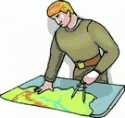Career Profile: Cartographer

What is a Cartographer?
When was the last time you looked at a map? Though you may not realize it, it probably wasn’t that long ago. Cartographers (or map makers) are usually associated with the paper incarnation of the navigation tool – the professional has learned to adapt to rapidly developing technologies. If you’ve looked up directions online, chances are a cartographer is responsible for building and updating the digital map you used.
Traditionally, a cartographer would draw the lay of the land on paper. Depending on the nature of the map and what its intended use was, maps would typically depict important markers like major landmarks and cities. Aerial photography, computer programming and worldwide networks have forever changed how members of this profession complete their work. For instance, have you ever seen the Google Maps car or used the ‘street view’ function? Using onsite photographs, cartographers are able to reconstruct locations around the world. Another crucial tool is satellite imagery; Aerial pictures taken by satellites allow cartographers to keep maps up-to-date, preserving accuracy.
Education and Skills
There are a variety of ways to become a cartographer, but a having an interest in geography, math and science is key. Cartographers usually have a bachelor’s degree in cartography, geography, surveying, engineering, forestry, computer science, or earth sciences. With the advent of digital information sources, a strong aptitude for computer programming is highly desirable.
Cartographers must be technically-minded and able to easily solve discrepancies in logic. Creating and maintaining geological and statistical data can be tedious work, making patience and endurance invaluable skills.
Salary
Most cartographers earn between $50,000-$60,000 annually.
Day-To-Day
Cartographers tend to spend the bulk of their time in offices working on computers. Much of their time is spent collecting, analyzing, interpreting and publishing data. Most of their work involves interpreting multiple factors, including but not limited to: landscape, law, climate conditions and changes in population and cultures. Mechanical drawing and map composition remains a fundamental part of the job, but these tasks are usually completed in a digital capacity.





Leave a comment!